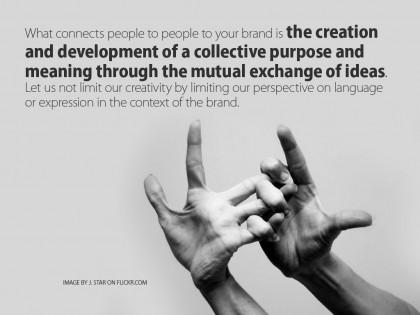People don’t connect online because they can talk to each other, they connect online because they through an exchange of ideas identify and define a collective purpose (and move it in a direction).
To me this is important, because it might suggest that when thinking about online participation, our inhibition to think outside the limits of our written and spoken language forces us to define language as just that – words. While conversation – which we embrace so dearly – has little to do with words, they are just a chosen and common way of expressing our ideas.
A bit out of context, but this clip on the autistic mind; In my language by Amanda Baggs presents one of the most beautiful perspectives on the limits of our “rational” imagination when it comes to language. (The first part ends at about 3min 15sec, the second part translates / explains ..)
Think of an online community connecting, sharing, moving on the basis of an idea – while not being allowed to use words to share it. The concept is not very uncommon. It’s even older than speech :o)
Aron Koblin’s experiments with the mechanical turk gives an impression:
Aaron Koblin at PICNIC08: The Sheep Market from PICNICCrossmediaweek on Vimeo.
The whole Line Rider phenomenon as well:
Understanding that conversation has less to do with the expression of the language shared and more to do with the ability to connect and create through ideas. We could also start to see that our ways of connecting with our participants today is too focused on getting them to talk to us (or each other), whilst this is not necessarily what will help us generate the most value
.
What connects people to people to your brand is the creation and development of a collective purpose and meaning through the mutual exchange of ideas. Let us not limit our creativity by limiting our perspective on language or expression in the context of the brand
sexual relationships, details of current sexual techniques, generic viagra online for sale f . Depression.
.


